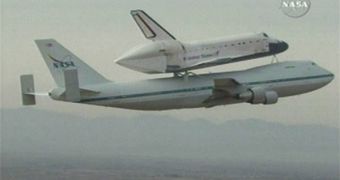Despite fears that it will not be able to take off due to technical issues, the space shuttle Atlantis took to the air yesterday, June 1, atop a shuttle carrier aircraft (SCA) Boeing 747 jumbo jet. The 100-ton orbiter was eventually installed without problems on its support, and every last piece of equipment had already been set in place until the time for take-off came. Overnight, the shuttle remained at the Biggs Army Airfield in El Paso, Texas, but, in the morning, it will fly east, towards the Kennedy Space Center, in Florida. The spacecraft's seven-astronaut crew is already at their base, the Johnson Space Center, in Houston, Texas.
The return flight began on Monday, at 11:06 am EDT (1596 GMT), after the engineering team at the Edwards Air Force Base in Southern California gave their go-ahead for launch. Because of its massive size, and the fact that it cannot fly on its won through the atmosphere, there really is no other option for transporting Atlantis than by land or sea. Naturally, going by sea would be very dangerous, and, by railroad or car, that's nearly impossible. With a shuttle made up of only three vessels, it’s understandable that NASA is willing to pay $1.8 million to have the shuttle brought back home.
It's been a week since Atlantis landed in California, after completing a successful 13-day mission to the Hubble Space Telescope. During five back-to-back spacewalks, the astronauts repaired two of the observatory's instruments and replaced two other, changed the gyroscopes, batteries and the thermal shield, and also added a new fine guidance sensor, to help better pinpoint the device. Altogether, during the nearly two weeks they were in space, the astronauts and their craft flew about 5.3 million kilometers around the world.
Originally, after the mission was done, and the craft was preparing for reentry, the orbiter was scheduled to touch down at the KSC on Friday, but bad weather delayed that plan. Eventually, after failing to land on Saturday, and on the first attempt of Sunday as well, with fuel and energy running low, the astronauts were instructed to land in California, in order to reduce the risk of anything happening to the ship and themselves.

 14 DAY TRIAL //
14 DAY TRIAL //